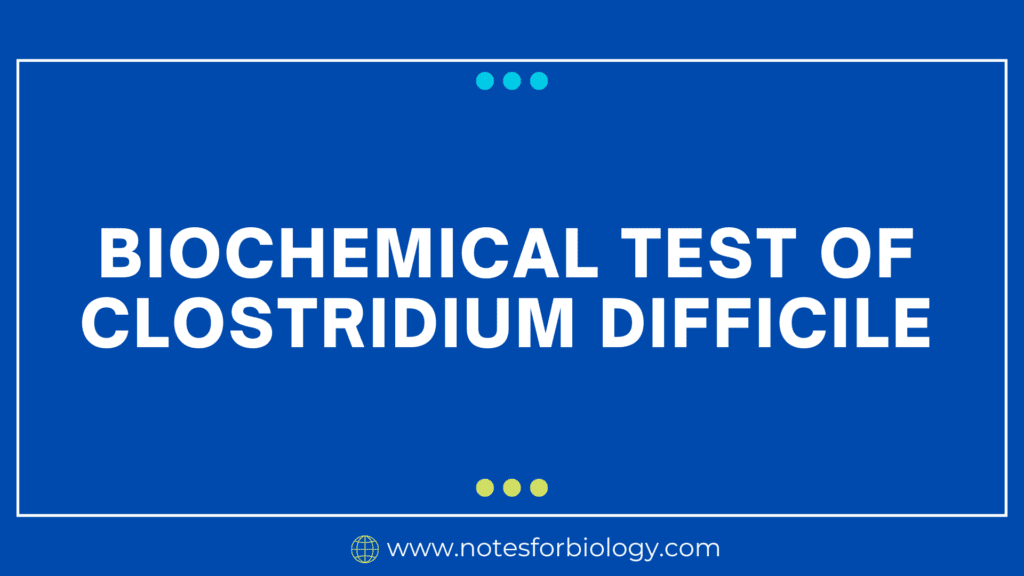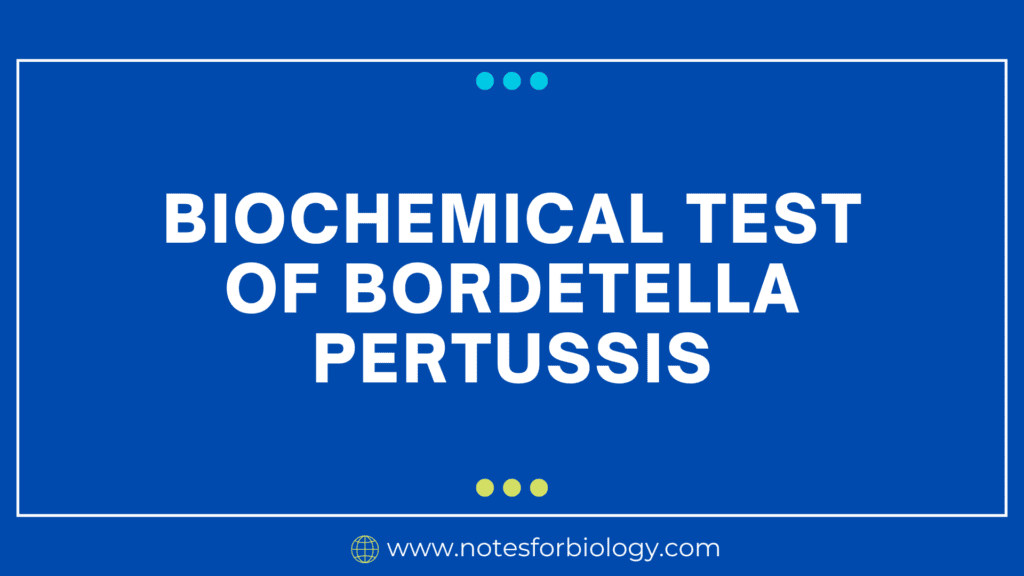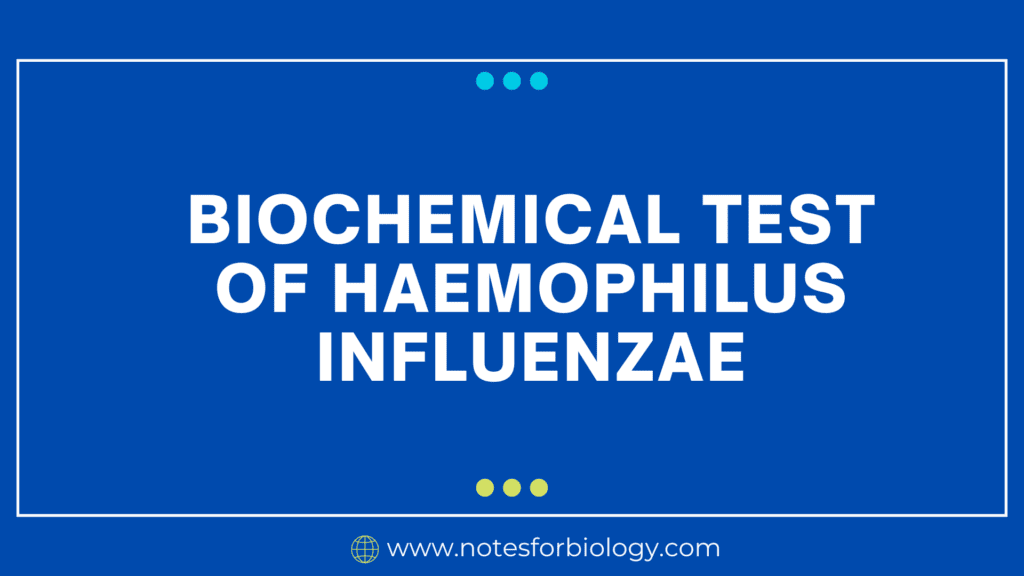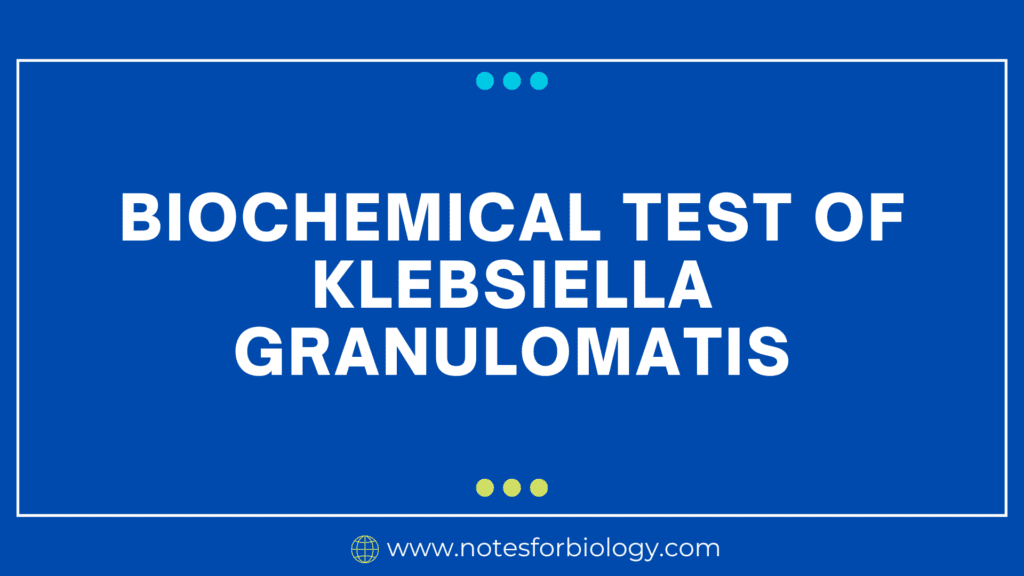Clostridium difficile (C. difficile) is an anaerobic, Gram-positive, spore-forming bacterium that can cause significant gastrointestinal diseases such as antibiotic-associated diarrhea and pseudomembranous colitis. The identification and characterization of C. difficile often involve several biochemical tests.
It (C. difficile) bacteria that is spore-forming, anaerobic, Gram-positive, and a major contributor to illnesses linked to healthcare (HAIs). It is most well-known for producing more serious illnesses including pseudomembranous colitis and diarrhea brought on by antibiotics. For the purpose of controlling and preventing infections, it is essential to comprehend its traits, modes of transmission, and pathogenic processes.
Table of Contents
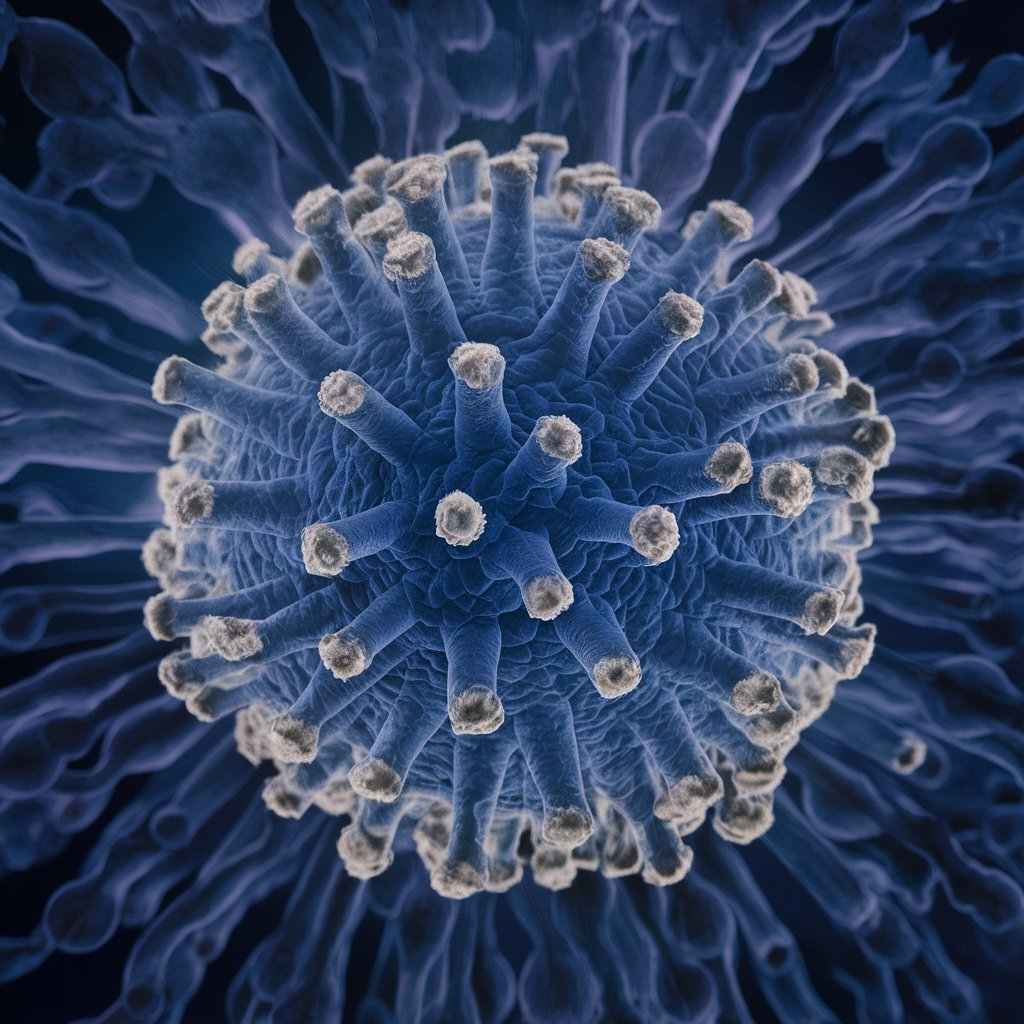
Here are some biochemical tests commonly used to identify and characterize Clostridium difficile:
1. Gram Staining
Gram staining is commonly used to identify Clostridium difficile, a Gram-positive bacteria, as the first step in its detection and characterisation process. Applying crystal violet and iodine to a bacterial sample, decolorizing it with acetone or alcohol, and then counterstaining it with safranin is the staining process. Under a microscope, Clostridium difficile appears purple or violet because it maintains the crystal violet-iodine complex in spite of decolorization. One of the primary characteristics that set Clostridium difficile apart from other bacteria is that it is Gram-positive. This helps with its initial identification before additional biochemical testing is carried out.
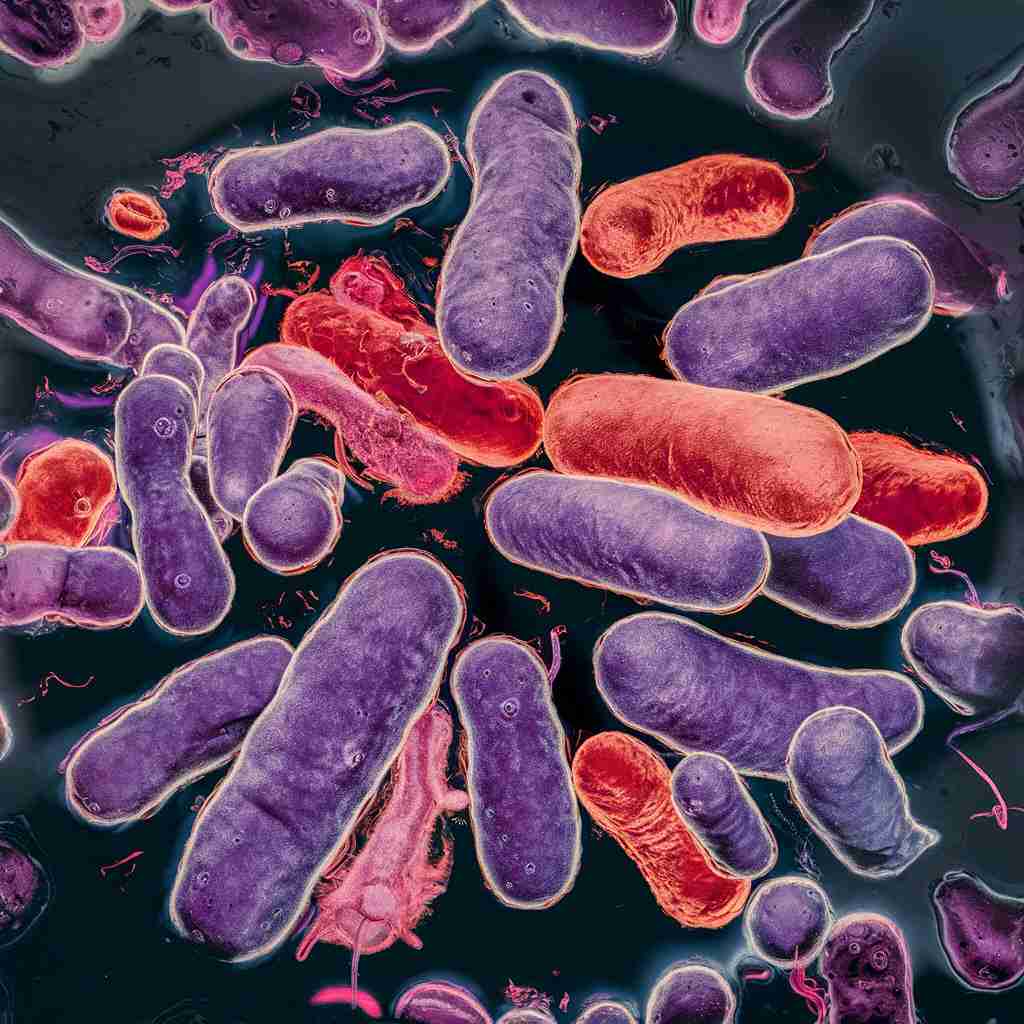
2. Anaerobic Growth
With its unique anaerobic growth pattern, Clostridium difficile flourishes in oxygen-free settings. It differs from facultative anaerobes, or aerobes, which are able to grow in the presence of oxygen, due to this property. For Clostridium difficile to survive and remain dangerous, it must develop anaerobically. This is especially true in the case of gastrointestinal illnesses, where low oxygen levels are common. Clostridium difficile laboratory cultures are usually cultured in anaerobic chambers or with specific medium that facilitate anaerobic conditions. An essential characteristic in the isolation and culture of Clostridium difficile for research and diagnostic purposes, its anaerobic growth preference has greatly advanced our knowledge of the organism’s biology and virulence mechanisms.
3. Lecithinase Test
The lecithinase test is used to determine whether Clostridium difficile is producing the enzyme lecithinase, also known as phospholipase C. This enzyme breaks down lecithin, a substance found in cell membranes, into diglyceride and phosphorylcholine. A culture of Clostridium difficile is streaked onto an egg yolk-containing media, like Egg Yolk Agar, in order to conduct the lecithinase test. The development of an opaque, white, or pearly zone of precipitation surrounding the bacterial colonies during anaerobic incubation is a sign of lecithinase activity. The breakdown of lecithin in the egg yolk produces this precipitate, which indicates the presence of the enzyme lecithinase. One important biochemical characteristic that can distinguish Clostridium difficile from other Clostridium species is positive lecithinase activity.
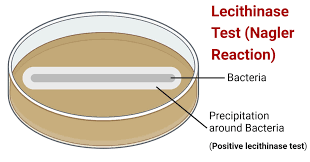
4. Production of Volatile Fatty Acids
Clostridium difficile uses anaerobic fermentation mechanisms to create volatile fatty acids (VFAs). These volatile fatty acids (VFAs), which include butyrate, propionate, and acetate, are metabolic byproducts that may be found and measured to help identify the bacteria. In a lab environment, gas chromatography, which separates and quantifies the volatile chemicals present in the culture medium, or specific biochemical tests can be used to evaluate the formation of volatile free acids (VFAs) by Clostridium difficile. As part of a series of tests to verify Clostridium difficile’s identification, the presence and distinct profile of VFAs are suggestive of the organism’s metabolic activity. The synthesis of VFAs is important for understanding the pathogenic processes of Clostridium difficile as well as for diagnostic reasons, since these acids
5. Indole Test
The indole test is performed to ascertain if Clostridium difficile can synthesize indole from tryptophan. The bacteria is grown in a tryptophan-containing medium and incubated under anaerobic conditions in order to conduct this test. The culture receives Kovac’s reagent once there has been adequate growth. The reagent will react with indole produced by Clostridium difficile to generate a red or pink molecule, signifying a successful outcome. Since not all Clostridium difficile strains are indole-positive, this test aids in strain differentiation and adds to the comprehensive biochemical profile required for precise identification. When used in conjunction with other biochemical tests to establish the presence of Clostridium difficile in a sample, the indole test is a valuable diagnostic tool.
6. Oxidase Test
The oxidase test is used to determine if microorganisms, such as Clostridium difficile, have the cytochrome c oxidase enzyme. This enzyme aids in aerobic respiration by participating in the electron transport chain. A sample of the bacteria is put on filter paper or in direct contact with an oxidase reagent, which usually contains a chromogenic reducing agent like tetramethyl-p-phenylenediamine, to conduct the oxidase test. The reagent becomes oxidized in the presence of cytochrome c oxidase, changing its hue to dark blue or purple in a matter of seconds. However, because Clostridium difficile is oxidase-negative, the reagent does not change color because it does not make cytochrome c oxidase. This unfavorable outcome contributes to the distinction of Clostridium difficile from other oxidase-positive bacteria.
7.Motility Test
The purpose of the motility test is to find out if Clostridium difficile has motility—the capacity to move on its own. The bacteria is injected into a semi-solid media, such motility agar, and the test is carried out by incubating it in an anaerobic environment. Growth of Clostridium difficile will be limited to the stab line where the injection was performed since the germs are normally non-motile. Should the bacteria be able to move, it would proliferate beyond the stab line, resulting in a dispersed growth pattern over the media. The identification of Clostridium difficile is further confirmed by observing the limited growth pattern typical of non-motile organisms, which corroborates the findings of other biochemical tests in the diagnostic procedure.
8. Toxin Production
The purpose of the motility test is to find out if Clostridium difficile has motility—the capacity to move on its own. The bacteria is injected into a semi-solid media, such motility agar, and the test is carried out by incubating it in an anaerobic environment. Growth of Clostridium difficile will be limited to the stab line where the injection was performed since the germs are normally non-motile. Should the bacteria be able to move, it would proliferate beyond the stab line, resulting in a dispersed growth pattern over the media. The identification of Clostridium difficile is further confirmed by observing the limited growth pattern typical of non-motile organisms, which corroborates the findings of other biochemical tests in the diagnostic procedure.
Frequently Asked Question
1. What are the biochemical tests to identify Clostridium?
The starch hydrolysis test, double zone hemolysis, nitrate reduction test, lipase-lecithinase test, iron milk test, lactose fermentation-gelatin hydrolysis test, and glucose, sucrose, lactose, and maltose fermentation tests were among the biochemical tests that revealed a positive result for C. perfringens.
2. What is the biochemical test for Clostridium tetani?
Gelatin is liquefied by the asaccharolytic species of Clostridium tetani, according to biochemistry. The species also produces DNAse and H2S, however it reacts negatively to nitrate reduction, aesculin, starch hydrolysis, and the activities of lipase and lecithinase.
3. What is the citrate test for Clostridium difficile?
The capacity of bacteria to use citrate as their only carbon source for energy is assessed using the citrate utilization test. This capability is reliant on the bacteria of a citrate permease, which helps move citrate into the bacteria. After entering the bacteria, citrate is transformed into CO2 and pyruvic acid.
Related Article

